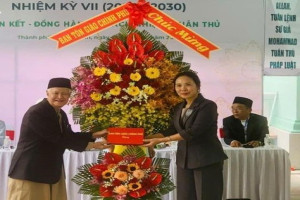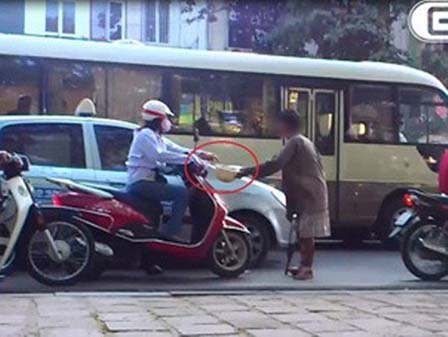
For those pretending to be people from charity organizations using counterfeiting authorized documents for raising money for their own uses and those pretending to be monks in order to usurp other people's property, it can be charged with fraud to appropriate properties by Article 139 of the Penal Code.
However, there are those abusing people’s mercy and hospitality for individual profit by disguising themselves as the disabled, the sick or the poor, or more serious pretending to be religious. This behavior of cheating seems to be very clear but to convict these people is not a simple matter.
Deceiving by wounds
On Highway 1A, districts 2, Ho Chi Minh City, people often see a middle-aged woman sitting with sickness appearance. If someone feels pity and stops to ask about her situation, she always talks about unfortunate situation, such as her children died of sickness or accident, or she had serious disease just waiting to die, so she is here to ask for mercy of passers-by to live through...
Many people fell pity for her and gave her money... However, on some social forums, the image of this "pitiful" woman has been exposed when people saw she was carried in early mornings and picked up late at nights by a healthy young man.
Some people found out that she lives in a house with her children in Binh Thanh area. Her children are gamblers and they often use the money their mother begged from the mercy of passers-by for self-indulgence and gambling.
There are many other beggars using self-made frightful wounds in order to make themselves pitiful in the eyes of the passers-by. They usually wrap their legs and use red color as blood on white fabric so old. Some beggars even make more sophisticated fake wounds, looking like real festering sores or burns....
Mrs. Phu, a street vender in Thoai Ngoc Hau area, Tan Phu ward, where a "fake-beggar village" was located, said that these beggars used such a patch and liquid to create effects that looked like real and scared festers.
According to Mrs. Phu, there are many types of patches and liquid used by these beggars to make different kind of injuries such as rough wound, ulceration, necrosis, burns...

The man using fake burn in his legs begging at Quan Su pagoda
"Stronghold of skinhead"
If compared to fake beggars, fake monks have more elaborate tricks to take money from believers or kind-hearted people. Recently, the press has discovered a "stronghold of skinhead" residing in Chau Doc station (An Giang province), and from there, the fake monks went throughout the western provinces for taking advantage of mercy from people.
There are kinds of fake monks asking for offerings of food and money, or selling incense for “raising money to build the temple”, then using this money for individual pleasures on degraded things.
Earlier, people felt indignant at an internet photo of a fake monks group gathering in a party with beer, wine and dog meat…
In Ho Chi Minh City, people can often see monks going individually or by groups every day to sell incense, ask for donation along streets. The Vietnam Buddhist Sangha does not allow monks to go to houses for selling incense or asking for donation and money to build temples, as well as prohibit mendicant monks from receiving money of people. However, many Buddhist devotees have still been cheated by these monk pretenders.
Besides, these fake monks use a lot of ruses to take money in the pocket of passers-by, such as observing target, asking with insistency right people including the rich and foreign tourists, using of persuading and clinging skills...
Only some cases can be fined
The fake beggars and monks have sophisticated ruse so that they are rarely detected. They choose quirky ways and different means of transportation, from motorcycles to buses, and change the costume and makeup to avoid attention. The authorities have difficulties to handle these beggars, and partially due to the fact that almost no denunciations from the community have been made.
Remarkably, these swindlers can make a big sum of money. According to Mrs. Phu, a street vender mentioned above, they usually make from a few hundred thousand VND to 1 million VND per person each day. Some investigations from press also show that the income of a pretending beggar is at around 30 million a month.
Therefore, it can happens that these beggars go on begging in the morning but wear expensive costumes and go to a luxury restaurant or bar in the evening, or even buy gold to save every month.
Analyzing the above-mentioned practice, lawyer Huynh Phuoc Hiep (Huynh Phuoc Hiep Lawyer Office, Delegation of lawyers in HCM city) explained: "The tradition of the Vietnamese people is "good hub leaves torn", so when meeting somebody confronting difficult circumstances, many people are willing to contribute some money to help them through distress. This traditional characteristic has been exploited by bad people.
The Vietnamese law has not had any regulation to deal with this kind of beggars. There is fraud in these beggars’ behavior but this fraud is not sufficient to constitute a defrauding or dispossession of property under the Article 139, and 140 of the Penal Code.
Currently, the Vietnamese law only provides administrative sanctions for cases of coercing or abusing children to beg for food or money with the fine from 10 to 15 million under paragraph 3 of Article 27 of Decree No. 144/2013/ND-CP.
For cases of those pretending to be people from charity organizations using counterfeiting authorized documents for raising money for their own uses and those pretending to be monks in order to usurp other people's property, it can be charged with fraud to appropriate properties by Article 139 of the Penal Code. Also, fake monks who entice people to buy statues or jewelry bracelets for luck may be convicted as making of fraud.
And, there is a serious consequence that this kind of fake beggars creates bad impact on people’s compassion for others, and then when people run out of mercy for the unfortunate, the life of those unfortunate will become more disastrous.
Ngọc Huy – Thanh Phúc (PLO)




